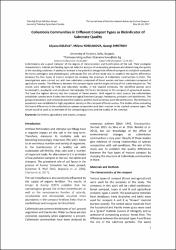| dc.contributor.author | Koleva, Lilyana | |
| dc.contributor.author | Yordanova, Milena | |
| dc.contributor.author | Dımıtrov, Georgi | |
| dc.date.accessioned | 2017-09-06T06:21:41Z | |
| dc.date.available | 2017-09-06T06:21:41Z | |
| dc.date.issued | 2017 | |
| dc.identifier.uri | https://hdl.handle.net/20.500.11776/2409 | |
| dc.description.abstract | Collembolans are a good indicator of the degree of mineralization and humification of the soil. Their ecological characteristics, habitat and feeding type can help the analysis of composting processes and determining the quality of the resulting substrate. A particular interest is the potential antagonistic effect of compost on soil plant euedaphic life forms pathogens and phytophagous arthropods.The aim of this study was to establish the quality differences between the four types of mature compost by studying the structure of Collembola communities in them. The investigations were carried out with two substrates composed of forest wastes and two substrates composed of agricultural wastes. The difference between the compost types was the origin and size of the substrate particles. The results were obtained by field and laboratory studies. In the studied composts, the identified species were hemiedaphic, euedaphic and atmobiont. Hemiedaphic life forms dominated in the compost of agricultural wastes. The have the highest density into the compost of forest wastes. With regard to food sources the collembolans established species were divided into three ecological functional groups: herbivores, predators and detritivores. The groups of predators and herbivores were the smallest, and the most numerous were the detritivores. The detritivores population was established in high population density in the compost of forest wastes. The studies allow evaluating the found differences in the collembolans species composition and their number in the studied compost types. The results could be used as an estimate of the composting process and the quality of the compost. | en_US |
| dc.language.iso | eng | en_US |
| dc.publisher | Namık Kemal Üniversitesi, Ziraat Fakültesi | en_US |
| dc.rights | info:eu-repo/semantics/openAccess | en_US |
| dc.subject | Collemlola | en_US |
| dc.subject | agricultural and wastes | en_US |
| dc.subject | compost | en_US |
| dc.title | Collembola Communities in Different Compost Types as Bioindicator of Substrate Quality | en_US |
| dc.type | article | en_US |
| dc.relation.ispartof | Tekirdağ Ziraat Fakültesi Dergisi | en_US |
| dc.department | Tekirdağ Namık Kemal Üniversitesi Dergileri | en_US |
| dc.identifier.volume | 14 | |
| dc.identifier.startpage | 1 | en_US |
| dc.identifier.endpage | 6 | en_US |
| dc.relation.publicationcategory | Makale - Ulusal Hakemli Dergi - Başka Kurum Yazarı | en_US |



















